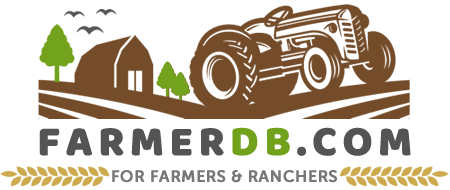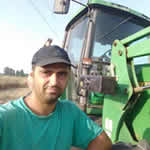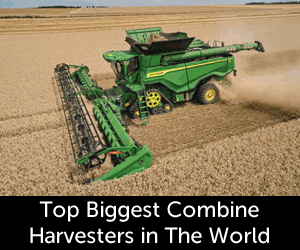The Dorper sheep is a domestic mutton breed from South Africa, developed by crossing the Dorset Horn and Blackhead Persian sheep.
The South African Department of Agriculture created it to produce a meat sheep well-suited for dry areas.
Farmers in South Africa (see refs.) now raise over 10 million Dorper sheep, accounting for more than one-third of the country’s total sheep population.
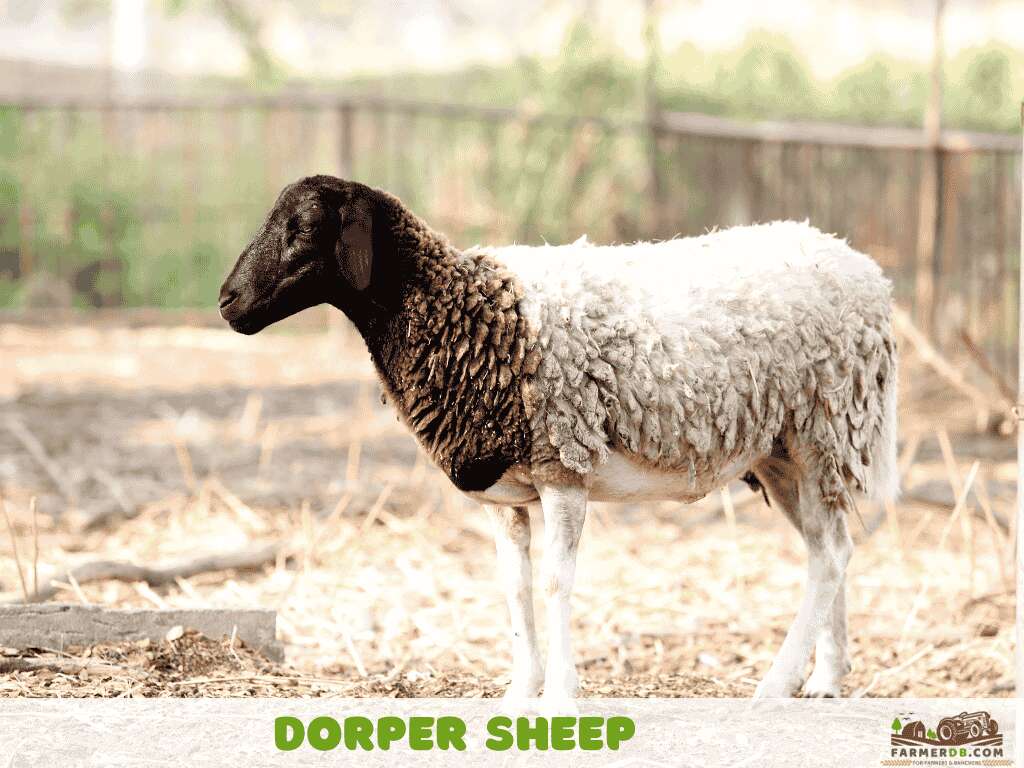
This adaptable breed has gained popularity worldwide, spreading to regions such as the Middle East, China, Canada, Australia, South America, Mexico, and the United States.
It is now one of the fastest-growing sheep breeds in the world, thanks to its adaptability.
Contents
Characteristics
Colors
Dorper sheep come in two main color patterns:
- Dorper (Blackhead): These sheep have a white body with a black head and neck, which is considered the ideal appearance. Small black spots on the body or legs are acceptable, but sheep with predominantly black bodies are less desirable.
- White Dorper: These sheep are completely white, but they must have proper pigmentation around sensitive areas such as the eyelids, under the tail, and on the teats. A few small spots on the ears or underside are allowed.
Skin
The skin is loose, elastic, and covered in a combination of hair and fine wool. It is pigmented, especially around sensitive areas.
Head, Face, Ears
The head of the Dorper sheep is strong and long, with eyes that are widely spaced and well-positioned for protection. It is covered with short, dull black hair in Blackhead Dorpers, while White Dorpers have short, dull white hair.
The face is clean and free from wool, with a smooth profile. It features a sturdy nose and a well-shaped mouth with deep, well-fitted jaws.
The alignment of the teeth ensures effective grazing, with the cutting teeth ideally contacting the upper gum. The forehead is smooth and well-formed, while the ears are medium-sized, slightly pointed or rounded, and symmetrically positioned.
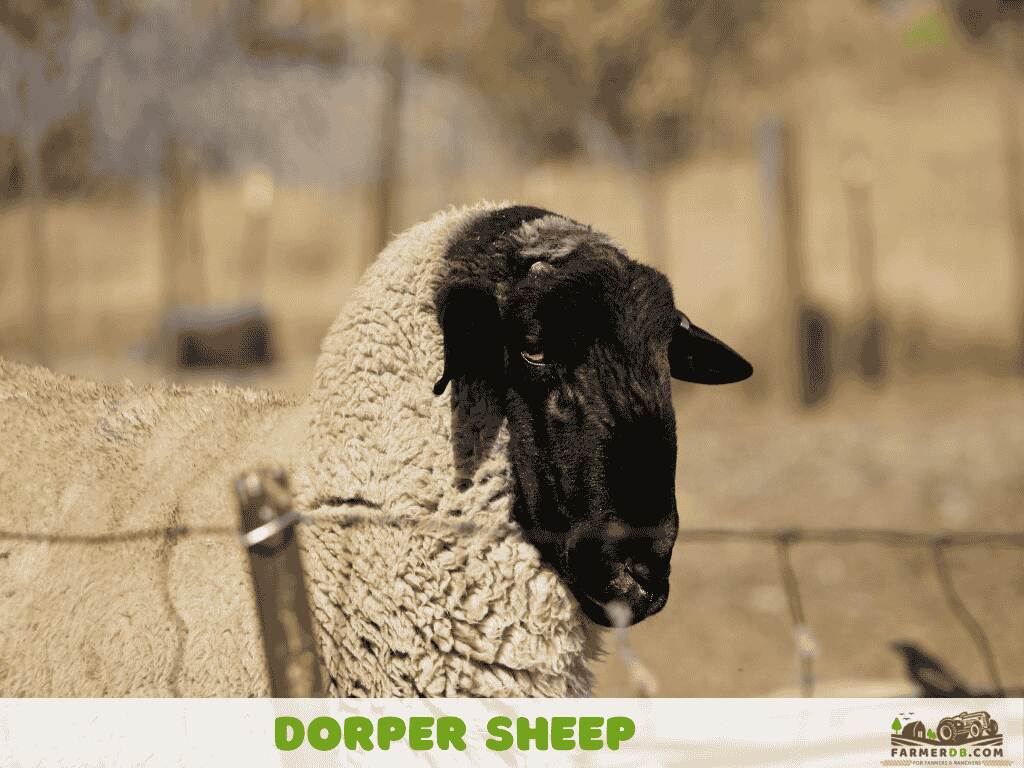
Horns
These sheep are generally polled.
But some of them may have a small horn base or rudimentary horns, which is considered acceptable in the breed standard.
Fore-Quarter and Neck
The neck is medium in length, broad, and well-fleshed, seamlessly connecting to the strong, well-built forequarters.
The shoulders are firm, broad, and robust, providing a solid foundation for the animal’s overall structure. The brisket has a moderate projection beyond the shoulders, with ideal width and good depth, reflecting the breed’s balanced conformation.
The forelegs are strong, straight, and well-placed, supported by sturdy pasterns and well-formed hooves.
Back and Underline
The back is broad, straight, and strong, running from the shoulders to the rump in a smooth, level line. The underline is well-defined, clean, and evenly proportioned, showing good depth in the chest and abdomen without sagging.
Hooves
The hooves are robust, compact, and designed to withstand harsh and rocky environments. They are neither overly wide nor split.
Udder and Testicle
The ewe has a well-developed udder and healthy reproductive organs, which are important for breeding. In rams, the scrotum is not too long, and the testicles are equal in size and properly developed.
The minimum testicle circumference when the ram is sitting is:
- 11.8 inches (30 cm) at 10 months of age
- 12.6 inches (32 cm) at 2-tooth stage
- 13.0 inches (33 cm) at 4-tooth stage
- 13.4 inches (34 cm) at 6-tooth stage and older
The scrotum can have a small split, measuring up to 0.60 inches (1.5 cm) deep from the deepest point to the base of the testicles.
Fleece
The Dorper sheep has different fleece types that are classified by Dorper associations, ranging from the lowest grade, H1, to the highest grade, H5. These classifications reflect the mix of hair and wool, as well as the texture and distribution across the sheep’s body.
- H1 (Lowest Grade): This fleece is either entirely coarse hair, dense wool, or a coarse, hairy mane. It is the least desirable type due to its dense and heavy nature.
- H2: The fleece is almost exclusively coarse hair or very dense wool. This type lacks the balance seen in higher grades.
- H3: The fleece is predominantly wool or soft fine hair with noticeable kemp on the outer thighs. A light mane or apron is acceptable, and wool may extend slightly onto the head.
- H4: This fleece has a loose mix of hair and wool, with wool more prominent on the forequarters. The head may have wool up to the crown, and the underline remains clean.
- H5 (Highest Grade): The fleece is a light, loose mix of hair and wool with a clean kemp undercoat. The head is covered in short, clean kemp, reflecting the ideal fleece type for Dorper sheep.
Size
They are considered a medium-to-large-sized breed.
Dorper sheep have an average wither height of 37 inches (95 cm) for males and 31 inches (80 cm) for females.
Their size is not as large as some specialized meat breeds like Suffolk sheep but is more robust than smaller breeds like Shetlands.
Lifespan
Dorper sheep have a lifespan of 10–12 years, which is considered good for sheep, especially given their primary use as a meat-producing breed.
Growth Rate
How fast do they grow?
Dorper sheep have a fast growth rate compared to many other breeds. They are efficient at converting feed into weight gain, with average daily gains ranging from 0.18–0.20 lbs (81–91 g) under extensive conditions and up to 0.46 lbs (210 g) in optimal conditions.
Weight
Mature rams reach 198–265 lbs (90–120 kg), and ewes weigh around 110–176 lbs (50–80 kg). At birth, males weigh about 11 lbs (5 kg), while females weigh approximately 9.9 lbs (4.5 kg).
| Age | Rams (lbs) | Ewes (lbs) |
|---|---|---|
| 6 Months | 118–120 lbs (53.5–54.4 kg) | 105–107 lbs (47.6–48.5 kg) |
| 9 Months | 152–154 lbs (68.9–69.9 kg) | 120–122 lbs (54.4–55.3 kg) |
| 11 Months | 175–177 lbs (79.4–80.3 kg) | 143–145 lbs (64.9–65.8 kg) |
| 2 Teeth (12–15 months) | 202–204 lbs (91.6–92.5 kg) | 155–157 lbs (70.3–71.2 kg) |
Slaughtered Time
Dorper lambs are slaughter-ready at 3 to 4 months of age, known for their good carcass quality.
At this stage, they can reach a live weight of approximately 79 lbs (36 kg), yielding a high-quality carcass weighing about 35 lbs (16 kg).
This results in a dressing percentage of around 44%, highlighting their efficiency as a meat-producing breed.
Shearing
They do not require shearing, which is one of their advantages.
They have a mix of hair and wool that naturally sheds, especially under good management and in appropriate climates. This self-shedding characteristic reduces the need for shearing, making them a low-maintenance breed.
However, in some cases, especially in cooler or wetter climates, they may retain some of their wool, and light shearing might be needed. If required, this is usually done once a year but is far less intensive compared to wool-focused breeds.
Temperament
Dorper sheep display a docile and manageable temperament, making them easy to handle for both experienced and novice farmers.
Their calm disposition allows them to adapt well to flock environments and interact peacefully with handlers during routine care or breeding processes.
In addition to their temperament, Dorpers are grazers and can graze for extended periods.
Meat
Dorper sheep produce high-quality meat with a mild, rich flavor and tender texture. The meat has a balanced fat ratio, providing enough marbling for flavor without being overly fatty.
As a non-wool breed, Dorpers lack lanolin, which eliminates the strong aftertaste found in meat from wool sheep. This results in a clean, delicate flavor that appeals to a broad audience.
The combination of lean meat, optimal fat content, and smooth texture makes Dorper lamb a popular choice for premium meat production.
Raising
Feeding
You can offer Dorper sheep a diet that includes a wide variety of vegetation, as they are non-selective grazers. Their diet can consist of grasses, shrubs, and forbs, with a preference for fibrous feeds like dry grasses, hay, and shrubs over grains.
When pasture is unavailable, high-quality hay like alfalfa or timothy makes a great supplemental feed. Other options include corn or grass silage and grains like barley, oats, or corn.
It’s important to provide a mineral supplement specifically formulated for sheep to meet their requirements for calcium, phosphorus, and essential trace minerals such as selenium.
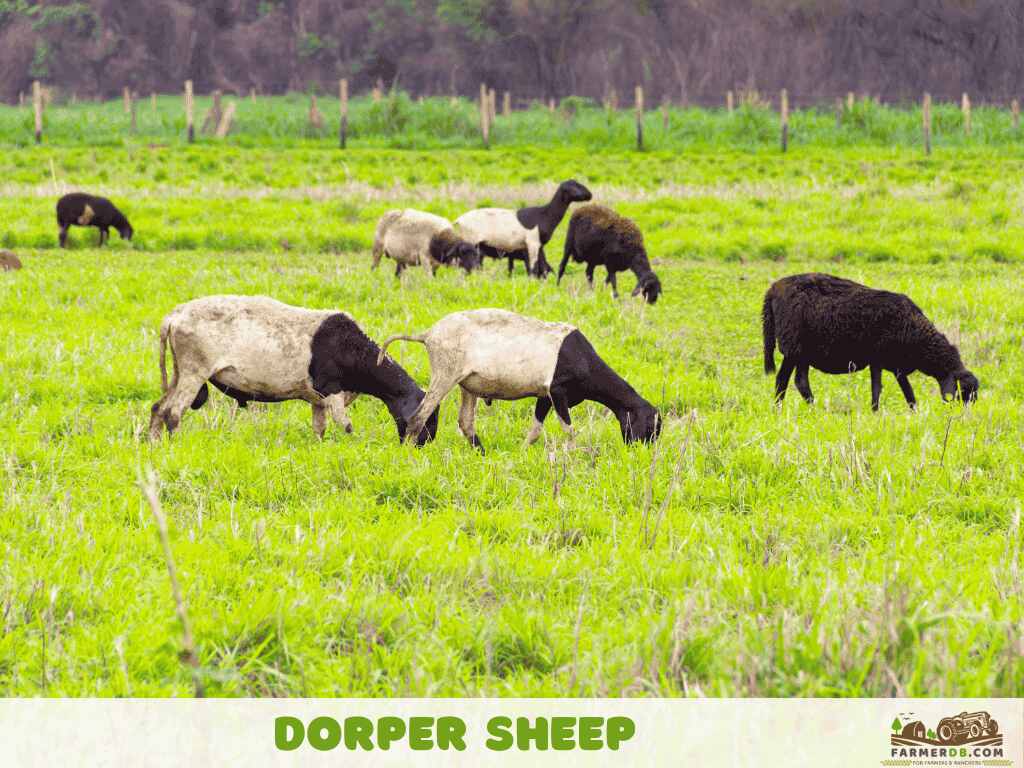
Also, ensure they have constant access to salt blocks and clean, fresh water at all times.
For pregnant and lactating ewes: Their diet should include higher levels of protein and energy to support their increased nutritional needs. This can be achieved by adding legume hays, protein blocks, or concentrates to their diet.
For growing lambs: Offering creep feed with higher protein levels (16–18%) is essential to promote rapid and healthy growth.
Environment
They are able to develop well in all types of environments.
They perform well in open pasture systems, where they graze freely on natural vegetation, as their grazing habits allow them to utilize a wide range of plants.
In semi-intensive systems, where grazing is supplemented with additional feed such as hay or grains, Dorpers show good growth rates and productivity.
They also adapt well to intensive systems, where they are managed in smaller, confined spaces and provided with carefully controlled diets.
Climate
They are well-suited to arid and semi-arid environments but can also perform effectively in temperate climates, provided they have access to adequate forage and shelter.
In areas with high rainfall or colder temperatures, adjustments such as providing dry bedding and supplementary feeding may be needed to support their health and productivity.
Shelter
They are hardy and adaptable, so they do not require elaborate shelter under most conditions. However, providing shelter is beneficial in certain situations:
- Protection from extreme weather: In areas with heavy rain, strong winds, or extreme cold, a simple shelter helps protect them from stress and health issues.
- Shade in hot climates: In very hot or arid regions, access to shade is essential to prevent overheating and ensure their comfort.
- Lambing season: During lambing, shelter can protect newborns and ewes from harsh weather, ensuring better survival rates.
- High-rainfall areas: In wet climates, a dry area for rest helps prevent foot issues and other health problems.
How many sheep per acre?
If your pasture is in very good condition and produces high amounts of forage, you can raise 6 to 10 Dorper sheep per acre.
If the quality is lower or moderate, the number of sheep must be adjusted accordingly. On moderate pasture, you can raise 2 to 4 sheep per acre, while in arid or semi-arid regions, the stocking rate may be as low as 1 sheep per 5 acres.
To determine the best stocking rate for your land, consider factors such as soil health, forage production, and seasonal changes, and monitor the pasture regularly to prevent overgrazing.
Breeding
Breeding Dorper sheep is a well-planned process that focuses on selecting healthy, high-quality animals to produce strong, productive offspring. It can be done through natural mating or controlled programs, depending on the farm’s management goals
They can be bred throughout the year, as they are polyoestrus, meaning they do not have a restricted breeding season.
It is recommended to plan breeding in alignment with pasture growth. This ensures that fresh pasture is ready when the new offspring arrive. Depending on your location, calculate the breeding period by identifying the month your pasture starts growing and counting a few months back.
These sheep reach sexual maturity early, with ewe lambs starting to cycle as young as 4 months. But it is recommended to breed them at around 8-10 months, when they have reached at least half their adult weight.
Rams are highly fertile and play a crucial role in ensuring successful reproduction. The breed itself is known for its high fertility, with a large percentage of ewes becoming pregnant during each breeding season.
In natural mating, a good ram can service up to 40 ewes per breeding cycle.
Farmers often choose rams based on specific traits, such as a lowline body with short legs, a muscular build (especially in the hindquarters), a long and deep body for premium meat cuts, parasite resistance, and strong hooves.
Some farmers choose to keep the ram and ewes together through multiple cycles to ensure successful breeding. Allowing 2 to 3 cycles (50-51 days) can significantly improve the chances of better outcomes.
The gestation period for Dorper ewes is approximately 5 months.
With proper forage and good management, Dorper ewes can lamb three times in two years, achieving an eight-month lambing interval.
Their lambs are usually of manageable size, and the ewes have a natural ability to give birth efficiently.
They are good mothers, providing good care to their lambs. Ewes have a lambing percentage of around 150% under ideal conditions, meaning many will give birth to twins. Good management can increase this to 180%, while extensive conditions yield a more moderate 100%.
In a flock with many first-time ewes, the lambing percentage is around 120%, as maiden ewes tend to have single lambs. On average, a Dorper ewe produces 2.25 lambs annually under optimal conditions. This level of prolificacy makes the breed highly efficient for meat production.
Line breeding, or mating a ram with his female offspring, is common practice to enhance desirable traits.
This can be done safely for 3-5 generations. Some breeders extend this up to 8 generations, but careful management is essential to avoid undesirable traits.
Health Issues
They are hardy and resilient, but like any breed, they can face certain health issues such as parasites, foot problems, copper sensitivity (see refs.), and pink eye. These conditions can often be prevented with regular health checks, maintaining good hygiene in their living areas, and providing a balanced diet.
Why should you raise it?
For farmers or homesteaders seeking a profitable livestock option, Dorper sheep are a reliable, low-maintenance, and highly productive choice. Their rapid growth rate allows lambs to reach slaughter weight quickly, ensuring fast returns on investment.
They are versatile grazers, capable of utilizing a wide range of vegetation, and their self-shedding coat eliminates the need for shearing, reducing labor and operational costs.
Dorpers adapt well to diverse diets and systems, and their high lambing percentage further enhances their productivity.
The price of a commercial Dorper ram or ewe is usually between $500 and $600, while purebred Dorpers can cost over $3,000 because of their high value as a top-quality meat breed.
Advantages
- Adaptability
- Low maintenance
- Fast growth rate
- High-quality meat
- Year-round breeding
- High fertility
- Strong maternal instincts
- Low input costs
Disadvantages
- Need for good management: Their non-selective grazing can lead to overgrazing if not managed properly in smaller areas.
- Potential for overbreeding: Their year-round breeding capability can lead to overbreeding if not managed carefully.
References
- Dorper Animal Enquiry link
- USDA Sheep and Goat Statistics link
- Dorper South Africa link
- American Dorper Sheep Breeders’ Society link
- Australian Dorper and White Dorper Association Inc link
- Copper sensitivity in small ruminantslink
Do you have any experience with the topic discussed here?
Would you like to improve the information shared and contribute your practical knowledge on the subject?
Your real-world experience as a farmer or rancher could greatly benefit other members, and the community would deeply appreciate your contribution.
